A story of almost 30 years and 16,000 text characters...
This story is dedicated to all those cyberpunks who fight...wait, wait, wait!
Wrong MSX game...
Okay, this story is actually dedicated to all pioneers of translation and rom-hacking. Nowadays, we have so many modern tools that game translation is easier than ever. Debuggers, emulators, resource editors, Python, 27" displays... And although modern games are much bigger and better in terms of graphics, there are still those who play the retro classics, and those who translate the retro classics.
My story began back in 1993, when my grandparents gifted me my first game console. It was a Famiclone called Panther YF-938, and it cost 50,000 rubles at the time of purchase. If I'm not wrong, that was exactly the monthly pension of a Russian pensioner in those days. Despite all the "delights" of living in Russia in the '90s, that was my childhood, so my memories of those days are fond ones. And since games for consoles were quite expensive back then, buying them was a luxury we typically didn't have, so we would usually trade for them with our friends.

Once, while discussing all the new cartridge games that were available, I heard from my friends about a game called "The Three-Eyed Boy." The title was intriguing to me, but that's all I knew about it. At that point in time, I was into games like Contra, Robocop 4 (which is actually Robocop 3), and Teenage Mutant Ninja Turtles. One day, though, I came across a bootleg Chinese cartridge, or "peizazhnik" (so named because the background depicts a paysage, or landscape) of this mysterious game.
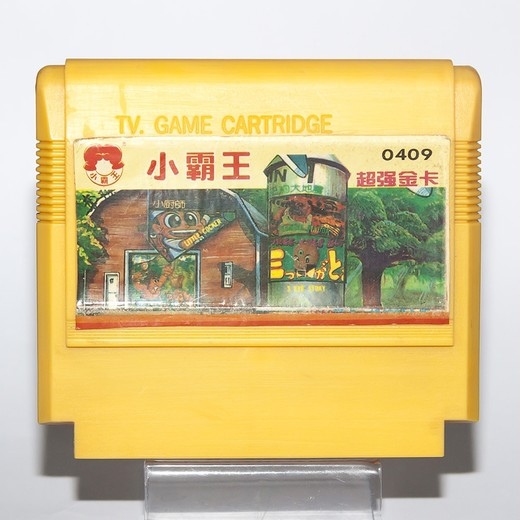
Having gotten my hands on the game, I blew into the cartridge (as one did) and inserted it into the console, then launched the game and, with great interest, started to go through the first level. And, as was often the case with new players of this game, I was taken down by jumping doggies.
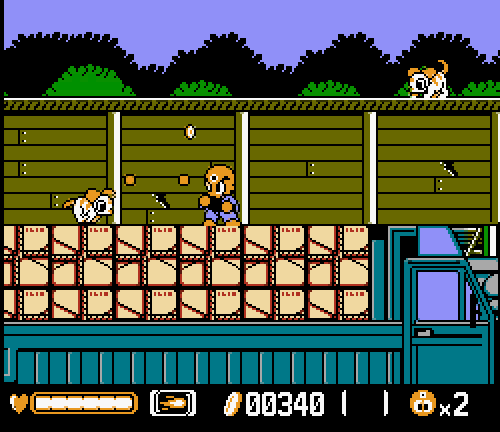
I persevered, though, and overcame the stubborn little doggies, moving on to level 1-2. But like so many others before me, I got stuck there, in front of an impassable wall.

As you may or may not know, the gamepads of all Chinese consoles at that time were equipped with turbo buttons. And having played a lot of Contra, we gamers of the time usually fired only with those turbo buttons. I couldn't have known that it was necessary to call the spear by pressing and holding the fire button, and since this was 1994, there was no internet to consult about it. And the Chinese cartridge came with no manual, of course, so after lots of futile attempts, I traded the game for another, and that was that. But the game hooked me with its Japanese setting and its sense of mystery.
I was left feeling unfulfilled. I wanted to play that game to completion.
I don't remember exactly how I found out about the spear (or the trident called Red Condor, to be more precise), but most likely one of my friends showed it to me.

So when I got my hands on the cartridge for a second time, I successfully passed stage 1-2, and advanced quite far in the game. A lack of Japanese knowledge and no manual couldn't stop determined little explorers lost in the world of console games back then, after all! I'd already found all the secret places in Duck Tales on my own, so using the same tactics in The Three-Eyed Boy (which was, if you haven't already guessed, Mitsume ga Tooru), I was able to find a number of secrets there as well. I even noticed how sometimes, when firing, my shots would strike something invisible, and this led me to find Moa, who throws coins! Not an infinite amount, but still really helpful.
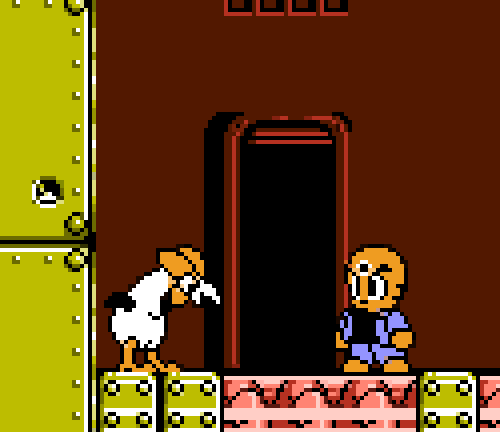
In general, gradually, level by level, I mastered the game. I got really nervous during a level with a falling ceiling and thorns, especially in places where you needed to summon the Red Condor and jump while dodging those thorns.
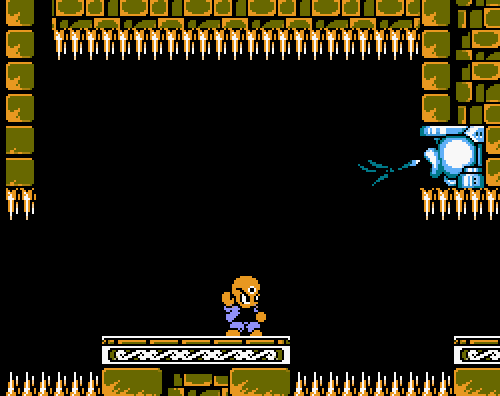
Through a lot of pain and suffering, however, I was able to reach the Tank of Gomorrah. After several attempts to learn the patterns by which the tank moves and shoots, I was able to defeat it, and felt like I'd completed the game. I was just waiting to see the game's end credits. But then Godal appeared and killed me with energy waves! I thought these waves had to be jumped over, but I just couldn't do it, so Godal killed me very quickly.
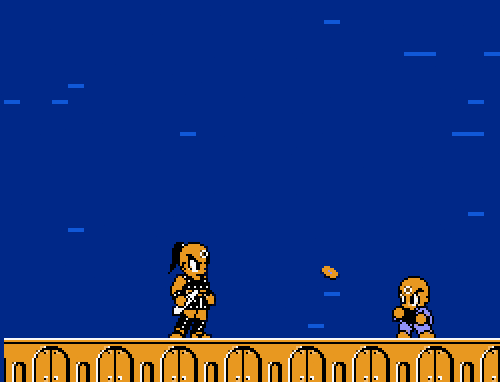
Because of that, I gave up on the game for a second time. Yet even despite that, the game remained in the back of my mind, and I found myself really wanting to learn who the main character is, whom he fights with, and what the name of his girlfriend is.
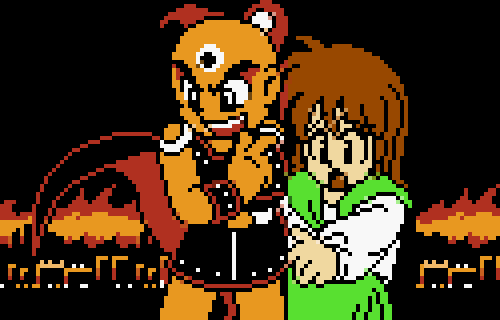
I managed to complete the game during the heyday of emulators in 2003-2004, I think. It was then that I first learned about rom-hacking and game translation. After trying to play Mitsume ga Tooru's translation, I found myself a little disappointed, because it seemed like there wasn't any real dialogue to translate -- instead, the game's cutscenes between each of the levels just described what was happening. So despite this "translation" existing, I still preferred to play the original Japanese rom for authenticity's sake.
And it was when I was searching for that rom that I came across a rom for an MSX game with the same name, "Mitsume ga Tooru." Though this one also had an English subtitle, "The Three-Eyed One Comes Here." And often the name of the rom would be followed by the words "3 Lie-Mon," too. If anyone knows what "3 Lie-Mon" means, I'd be really interested to find out!
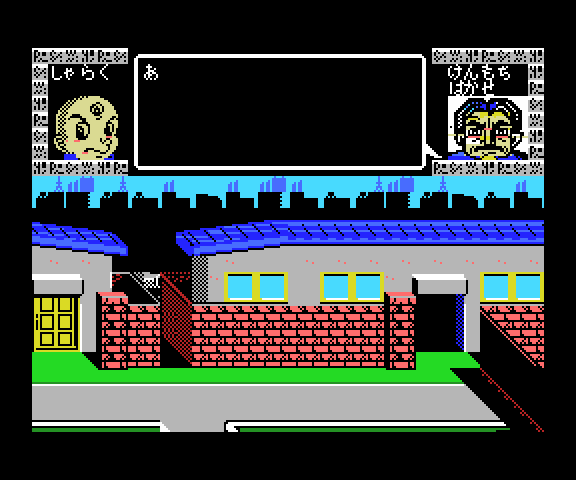
After trying to play the game on an emulator, I quickly wound up setting it aside. It was graphically much worse than its Famicom cousin, after all. But still... something about it had me hooked. Maybe it was that theme music, sinking deep into my soul, or maybe my childhood interest in "The Three-Eyed Boy" had subconsciously predisposed me to want to know more about this franchise. Either way, I never really stopped thinking about this game -- not completely, at least.
The noughties passed, and the teens came marching in. It was the heyday of YouTube. I periodically returned to have more fun with Sharaku on my emulators, and tried to dig up any new information I might be able to find, but there just wasn't a lot to go on. In 2015, I watched Pavel Grinev's video, "The Curse of the Gray Elephant" (a Russian analogue to AVGN). Before I saw this video, for some reason, I thought that nostalgia for retro games and other childhood things was fairly rare -- not just in Russia, but pretty much anywhere in the world. But no, clearly, there were a lot of people like me! Pasha Kinaman (Pavel Grinev) revealed to me a whole new side hobby to latch onto in the depths of my busy adult life with all its eternal concerns. And it was then that I learned how the retro community had transformed from underground into mainstream, bringing with its new status all the expected perks: the ready availability of information about games and their history, along with the ability to play remakes and rereleases of old games on modern platforms, or on emulators, or on modified consoles from back in the day, to say nothing of the latest trend in retro gaming: consoles reconstructed on FPGA.
But this retro renaissance had a dark side, as well. Due to the rise in popularity of retro-gaming, the prices for games and consoles skyrocketed, and are still growing by leaps and bounds to this day. It's hard to say if they'll ever plateau, or if they'll just keep rising! Granted, as the owner of some rather rare treasures, a part of me is kind of glad that their value is going up. But at the same time, I understand that collecting is no longer a hobby that the general public can just casually engage in anymore. And although I condemn piracy, I understand that sometimes, in order to replay favorite childhood games or discover their contemporaries and learn a bit more about gaming history, it's necessary to resort to such "gray" solutions as emulators and FPGAs. And game studios don't always want to re-release their old games, either, since they're of course more focused on profiting from their new games.
I returned to Mitsume ga Tooru for a fourth time in 2017 -- it seemed to be about the right time for it in my nostalgia clock. Having not forgotten the game of my childhood, the desire to add it to my then still small collection was reaching a fever pitch. And the lack of any clear information or any sort of digitally preserved manual for the game pushed me to pursue a CIB cartridge above all else. It was ultimately my wife who managed to find and gift me one as a New Year's gift, for which I'm very grateful. Thanks to her, scans of the manual and box are now properly documented on the internet, giving Hosuke Sharaku a little bit of the fanfare he's always deserved. And even though the book had been quite satisfactorily closed on my childhood gestalt, several events followed this which led to the beginning of a new story.
I was gradually getting into the history of retro-gaming myself at this time, and that's when I began to delve pretty deeply into Japanese gaming culture. I got acquainted with many masterpieces on many different gaming platforms, from many different game studios. But as in my childhood, I had a definite predisposition toward 8-bit games. And it was in my deep dive for hidden 8-bit gems that I rediscovered the MSX platform, which I'd first encountered in 1996 when I was attending high school. My "informatics" teacher was a man named Lyuty Victor Mikhailovich, and despite such a formidable name (Lyuty means "fierce"), he was actually a very kind, very good teacher. :) He was the one who introduced me to the MSX platform and spurred my interest in programming. And even though this was the tumultuous year of 1996, thanks to my mom and dad, I became the proud owner of a Pentium 133 personal computer! So in my memories, the glow of a green EIZO monitor, and the sound of the MSX Yamaha YIS-503IIIR KYBT2 keyboard I was using at school, still hold a warm place in my heart.
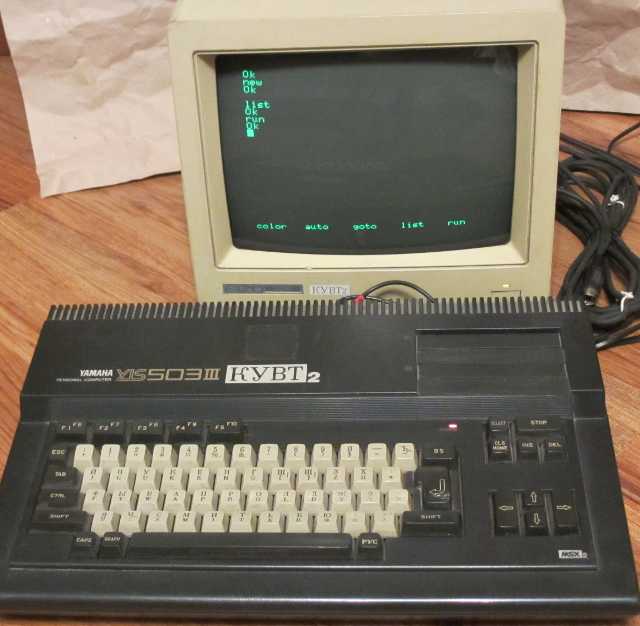
Having re-acquainted myself with MSX, I learned about the many masterpieces that came out on this platform: Snatcher, SD Snatcher, Space Manbow, Gradius, Mr. Ghost (a.k.a. Yuureikun) etc. As you probably know, most of the games released on MSX came out in Japanese. But thanks to enthusiastic translators, I was able to enjoy a lot of games that would've otherwise been unplayable for me. The contributions of Manuel Pazos, Daniel Caetano, Takamichi Suzukawa, Max Iwamoto, Thomas Lipschultz, and many others allowed people to play games that had never been published in any European languages.
Artemio Urbina is one such enthusiastic translator, and I would highly recommend visiting his website, which is something of a Snatcher and Policenauts virtual museum. Because of my interest in Snatcher and Policenauts, in September 2018 I wrote to Artemio and asked where and how to start if I suddenly decided I wanted to try translating Snatcher into Russian. Artemio gave me some basic pointers, for which I was quite grateful, but I wound up putting my plans to translate those games on hold due to their high text volume. Plus, it turns out there was already a guy on the forums translating Snatcher into Russian, so I was beaten to the punch!
My interest in translating remained, however, so I simply bode my time by building up my own Snatcher and Policenauts collection. All the while, I was monitoring sites and auctions in search of the Yamaha YIS-503IIIR KYBT2, since at that time I had already started collecting consoles and modifying them for RGB, and had learned just how fun it was to game on real old hardware using various mods, flash cartridges, and OSSC.
In the process of beefing up my Snatcher collection in September 2018, I met another collector named Sergey who went by the nickname TwilightWolf. This was in the GBX flea market, and he sold me Snatcher and Policenauts for different generations of consoles at a very good price. I stumbled upon the ad by accident, as I mainly bought SuperHIK (a Famiclone) and Famicom cartridges there and wasn't really looking for anything like this. But as I scrolled past the ad for the Snatcher sale, I noticed at the end that it said if I bought the whole collection, he'd throw in a Yamaha KYBT2 for free!!!!!!!! Needless to say, I "snatched" that up lickety-split. Unfortunately (though eventually it would turn out to be a minor blessing in disguise), one of the SD Snatcher floppy disks was damaged, perhaps due to the aging of the media. I was a little upset... but I got over it pretty quickly, and moved on to other things. I kind of forgot all about it after a bit.
By that time, I had already become closely acquainted with Japanese auction sites, and had purchased a number of other rare specimens for my collection. One of these was Mitsume ga Tooru for MSX -- the only copy I'd ever seen in several years of searching. There were no scans of the manual or box art to be found anywhere on the internet, just as was the case with the Famicom game. As such, I knew I had to add this game to my collection, if only for preservation's sake. By then, several videos about Mitsume ga Tooru had already been released in Russian and English on YouTube (you can find the links in the THANX section), so the curtain had been at least partially raised on the mystery of Sharaku Hosuke's wild adventures (I highly recommend the video by Game Dave).
With this and other MSX games in my collection now, I found myself periodically visiting the MSX Resource Center website (msx.org), and it was there in February 2019 that I came across a WTS post for loose floppy disks of SD Snatcher from a participant who went by the name Wyrdwad. I purchased these floppy disks from him, and while discussing the deal, I found out that his real name was Thomas Lipschultz, and he was a former professional game translator who now translated MSX games for fun. I told him about my game translation plans, and he reacted positively, encouraging me to give it a shot and expressing a fondness for Mitsume ga Tooru on MSX when it came up. He noted that the game was on his own short list of games he was hoping to one day translate, though he was happy to pass that honor along to me if I wanted it. He also mentioned that he was open to helping me with editing, should I decide to do any translation work for MSX projects in the future. And this was also around the same time I first discovered the Project Melancholia patch for SD Snatcher, which was the straw that broke the camel's back for me: I knew that I wanted to try translating Mitsume ga Tooru on the same professional-grade level as Project Melancholia.
I forgot to mention, but by this point, I had already been studying Japanese for two years at a Japanese center in Sakhalin, which pushed me even more to try my luck with translation. And so the stars converged in November 2019, when I, being in Yekaterinburg, came across the Mitsume ga Tooru VKontakte group, in which I saw screenshots of a translation from Andrey Obritan.
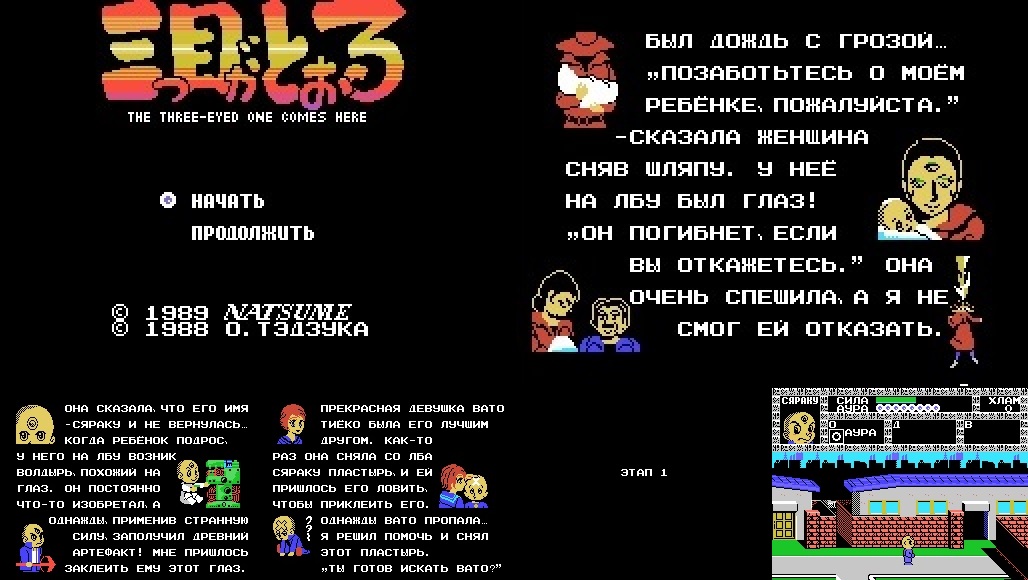
Then I saw English GIFs featuring the game's translated ending, though I quickly learned that sadly, they were just mock-ups.
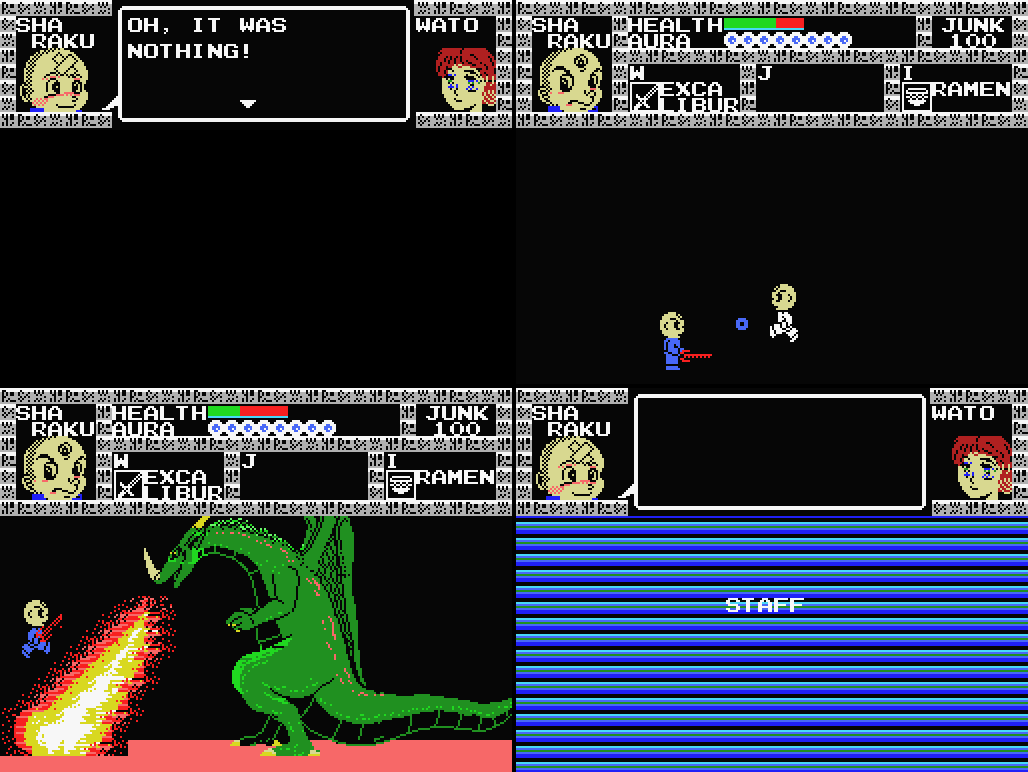
But seeing all of this flipped a switch in me, and I simply couldn't wait any longer. During my week in Yekaterinburg, I scoured the MSX pages of chief-net.ru site, digging up every last morsel of information I could find about rom hacking. Unfortunately, there was little information about MSX specifically, so I had to delve deeper than I would've liked! But there were ultimately plenty of tools to be found that would help me to this end: resource editors, for example, and emulators with debuggers (listed in the links below). Quickly enough, I extracted the text from the game's intro, along with the characters' name tags and a few pieces of dialogue here and there. All kinds of MTE, DTE, and the many other "joys" of rom-hacking were barely making sense to me, but I didn't let that stop me. I meticulously pieced together exactly how the game stored and packed its resources, text characters, etc. And seeing that I was having some success, I also registered the Mitsumegatoo.ru domain to host the game's translation.
But here, in the midst of thoroughly dissecting the game rom, at the beginning of 2020, I was caught up in a big move to another apartment, and I wound up having to postpone the translation for a while.
Since this was 2020, however (the year we all lost to COVID!), my wife and children flew to stay with relatives, and I had some time alone (for better or for worse) to dig deeper into the rom. It was tough going, though. I was pretty well stuck in the mud, so to speak. I started digging through posts on msx.org, debugging, experimenting, and trying to revive my old Assembly skills (Z80 Assembly in particular). I also picked through the experiences of my predecessors, such as the Project Melancholia, Oasis, and Metal Gear translations. I got to know a lot of people on msx.org: Manuel Pazos, Takamichi Suzukawa, Nekura_Hoka, Maarten ter Huurne and Manuel Bilderbeek (the OpenMSX evangelists), BiFi (who wrote very good manuals), and other very kind and helpful people. The most active of these users seemed to be Manuel Bilderbeek, who always explained everything in great detail -- perhaps more than was necessary or desired, in many cases. :) Although I wasn't really asking a LOT of questions on IRC or msx.org, the information I gathered in both places really helped me out a lot.
As a result, the game began to succumb to my wiles, and I even started keeping a log on the translation process, which can be found here. I finally extracted ALL the text, and quickly figured out how to replace the font with English, but realized that the length of the translated sentences would need to be considerably bigger than in the original language, and I had to somehow fit all those extra bytes into the rom. I could shorten the text and do it as in the Oasis project (they're the pioneers of rom-hacking as such, I'd say), but the quality of Project Melancholia's work just wouldn't leave my head, and I wanted to at least somewhat match that if I possibly could. So I took to experimenting with the text output procedures, and figured out how to add memory banks to the existing rom, and how to switch them on the fly, which allowed me to insert a lot more text than the original rom could handle. I was determined to live up to the high standards set by Melancholia, as rom-hacking had really come a long way since the translation of SD Snatcher by Oasis, due in no small part to the arrival of top-quality emulators and debuggers.
During the translation process, I contacted Wyrdwad (Thomas) again, and asked if he'd be willing to edit my English translation, since English is not my native language. He agreed to help, and I actually found out from him that he was working on another fan-translation at the time for an RPG called La Valeur, which he was doing with Max Iwamoto -- the main programmer for Project Melancholia, who turned out to be a fellow Russian programmer living in Canada! Such a small world sometimes. :)
(Editorial note from Wyrdwad: The La Valeur fan-translation is still planned, but progress on it has been temporarily put on hold due to IRL distractions preventing me from giving it my full attention right now; apologies to anyone who's been waiting for it!)
Then there was the routine work of polishing the code and correcting errors, and the not-so-routine work of experimenting with minor quality-of-life improvements in the gameplay and massaging the text for a more dynamic localization. While working with Tom, we had several quite long breaks for reasons beyond our control, but after much ordeal, we've finally managed to overcome all of our difficulties, and now, on April 20, 2021 -- the 32nd anniversary of the game’s original debut -- we are releasing this project to the wild for all fans of MSX games and the works of Osamu Tezuka (the creator of Sharaku Hosuke, and one of the fathers of Japanese manga). In total, this translation project took a little over a year to complete, from November 2019 to April 2021.
A big thank-you to those of you who read this all the way to the end.
